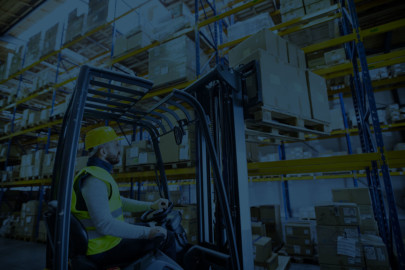AI-Driven Order Fulfillment: Efficiency, Accuracy, and Customer Satisfaction
Once an online shopper hits “Place Order,” the clock starts ticking. If delivery is five to ten business days, consumers see five. This is especially true if customers pay for shipping. Buyers want their purchases delivered quickly and in pristine condition with no errors in contents.
Retailers want the same thing. They want their merchandise to arrive as quickly as possible and without damage. They want the order to be filled correctly the first time to minimize returns. Merchants need logistics partners that deliver accurate and efficient services to meet customer expectations.
Finding third-party logistics (3PL) companies that deliver exceptional service can be challenging. With a projected annual growth rate of 14.8%, the eCommerce market continues to pressure 3PLs to find faster and more accurate fulfillment technologies. At the same time, logistics firms face shrinking warehouse space, labor shortages, and an uncertain economic landscape.
Technology such as artificial intelligence (AI) and machine learning (ML) can help meet the growing demands for accurate and efficient deliveries. With AI-driven order fulfillment, logistics providers can:
- Improve workflow efficiency
- Enhance warehouse operations
- Manage inventory
- Optimize human resources
- Ensure accuracy
- Make faster deliveries
AI can process volumes of data quickly to help 3PLs manage inventory more cost-effectively. AI-driven order fulfillment can improve workflow efficiency by streamlining operations, identifying bottlenecks, and automating labor-intensive tasks. The technology can improve order fulfillment processing by delivering a better customer and employee experience.
Improve Workflow Efficiency
Shipping requires an astonishing number of documents. There are commercial invoices, bills of lading, and packing lists. If importing or exporting is involved, the documents can easily double. As volumes increase, staying ahead of the paperwork can be a challenge.
Many logistics providers have adopted robotic processing automation (RPA) software to help with shipping paperwork. RPA mimics the keystrokes or actions of employees. It chooses what to include or exclude based on decision trees built into the software. It works great until something changes.
When countries change their documentation requirements, someone must reprogram the software to address the changes. With an AI-driven solution, the technology can make more complex decisions. It can check country requirements to ensure documents are up-to-date. The solution can compare information to eliminate discrepancies, making for a more efficient supply chain.
Enhance Warehouse Operations
Datapoints are part of every logistics operation. Managers track dwell time, travel time, and route efficiency. They have thousands, if not millions, of data sets but are too overwhelmed to know how to use them effectively. Trying to make sense of information on a spreadsheet is time-consuming and lacks the sophistication of an automated logistics system.
With AI, companies can assess their processes for efficient supply chain management. For example, how long does it take for warehouse staff to locate items for shipping? It takes seconds for an AI program to locate an item and deploy an automated retrieval robot to pick the item for packing.
Automated guided robots (AGR) and automated mobile robots (AMR) are expected to control 18% of warehouse operations by 2026. These robots are programmable and do not require special floor plans to operate. As part of an AI system, AMRs, and AGRs can streamline warehouse operations.
Manage Inventory
Making sure there’s enough of the right product at the right time takes a little bit of magic. It requires careful monitoring of products and an accurate estimate of how quickly orders are processed. It means assessing buying behaviors and seasonal trends. Too much of slow-moving items take up valuable warehouse space. Not enough means backorders.
Most inventory systems set a threshold value to trigger product reorders. When the threshold is reached, the customer is notified so more stock can be ordered. The process happens regardless of changes in market demand.
AI was built for inventory management. It uses huge datasets to track the ebb and flow of products out of a warehouse. From this information, AI tools can identify patterns in product movement to help forecast supply and demand. For example, a product reaches its threshold two weeks before a historical spike in sales. The standard reorder is placed, resulting in a rush order as the sales spike hits.
With AI, the software analyzes the data, recognizes the spike, and determines how much more of the product is needed to cover the anticipated increase in sales. That amount is added to the reorder, ensuring that sufficient product is available to meet demand. The retailer meets the increased demand without adding the cost of a priority order.
Optimize Human Resources
Labor shortages continue to plague the logistics industry. A 2023 survey found that 34% of respondents said they had to turn away business because of labor shortages in 2022. Of those walking away from revenue, 64% said the lost revenue would have equaled 25% or more of their total business. The labor shortage has forced logistics companies to look at staffing differently.
Attracting and retaining employees has challenged the logistics industry for years. Despite pay increases over the last three years, employee retention has failed to keep pace. Of those surveyed, 53% said that flexible work schedules were a better indicator of staff retention than salary increases.
More 3PLs are turning to flex workers to help fill that gap during peak periods. In 2022, 69% of respondents used flexible labor to meet staffing needs. That was up over ten percentage points over 2021. While flexible work hours may attract more employees, it does present a problem when it comes to scheduling.
AI can help 3PL providers optimize their workforce. For example, a logistics company needs three people to help pick and pack a rush order. The manager could spend days sorting through the information to find someone who fits the schedule or waste time making phone calls. The model can easily identify those applicants that meet the criteria in terms of availability and skillset, saving time and resources.
Ensure Accuracy
Accuracy in order fulfillment is as crucial to customer satisfaction as fast delivery. No matter how quickly a package arrives, if it’s the wrong item, the fast delivery doesn’t count. The customer is focused on what they didn’t get. A 2020 holiday survey found that 53% of consumers will not do business with a retailer that delivered an incorrect order.
Peak seasons are especially hectic for 3PL providers and their customers. Increased demand, shipping delays, and work shortages create the perfect environment for order fulfillment errors. As employees rush to fill orders, it’s easy to grab the wrong item. While errors in order fulfillment happen, consumers are less forgiving during the holidays. The wrong item means a last-minute shopping trip for a replacement gift.
AI can improve customer satisfaction in logistics through error-free fulfillment. Putting systems in place that check and cross-check item codes ensures that the right item is selected. Technology doesn’t feel pressure to deliver. It operates at the same pace with the same accuracy 24/7.
Make Faster Deliveries
Faster delivery times happen because of incremental improvements in the logistics process. Whether through improved warehouse operations or better inventory management, AI optimization in fulfillment increases customer satisfaction. Streamlining document preparation is only the beginning of what AI can do to make warehouse workflows run smoothly.
AI-driven order fulfillment enables faster deliveries through various optimizations, such as predictive maintenance, routing optimization, end-to-end visibility, and performance insights.
Predictive Maintenance
Letting an AI tool analyze data from sensors and equipment allows for proactive equipment maintenance. Downtime is reduced, and maintenance costs are less. Instead of waiting until equipment fails, AI systems can alert warehouse staff to possible equipment failures. Maintenance can be scheduled to minimize disruption. Warehouse operations run smoothly for faster delivery times.
Routing Optimization
AI-powered robotic solutions are costly; however, AI can still optimize warehouse operations without AMRs. AI systems can consider picking frequency and product characteristics to design optimal storage capabilities. The model can sequence orders to maximize travel paths and reduce backtracking to complete orders more efficiently.
End-to-End Visibility
Warehouse managers often lack the information needed for comprehensive visibility of warehouse operations. Combining AI with other advanced automation technology, managers can track inventory and monitor storage locations. They can evaluate existing processes to identify potential bottlenecks before they occur. AI enables warehouse managers to deliver continuous improvement in operations by highlighting problems to be addressed before they impact delivery times.
Performance Insights
AI works 24/7, analyzing data. It extracts data from multiple sources to detect anomalies and predict possible disruptions. Suppose an AI algorithm detected slight delays in an established trucking route. The delivery times were only a few minutes less. Highlighting the change enables a logistics provider to look at the route to find that traffic patterns were causing the delays. The route was altered, and delivery times returned to normal.
Receiving data in real time enables 3PLs to fine-tune their operations to match a changing landscape. They can address internal operations to improve accuracy. They can review information that underscores changes in external factors such as weather or unrest. With these capabilities, 3PLs can deliver a higher standard of customer satisfaction.
AI-Driven Order Fulfillment with Symbia Logistics
Overall, AI-driven order fulfillment offers a comprehensive solution to meet customer expectations and improve logistics operations in the eCommerce industry.
If you’re looking for a logistics partner that understands the value technology has for the industry, contact us to discuss how our operations can meet your order fulfillment needs.










